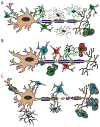Microglial process convergence on axonal segments in health and disease
- PMID: 34007863
- PMCID: PMC8128155
- DOI: 10.20517/2347-8659.2019.28
Microglial process convergence on axonal segments in health and disease
Abstract
Microglia dynamically interact with neurons influencing the development, structure, and function of neuronal networks. Recent studies suggest microglia may also influence neuronal activity by physically interacting with axonal domains responsible for action potential initiation and propagation. However, the nature of these microglial process interactions is not well understood. Microglial-axonal contacts are present early in development and persist through adulthood, implicating microglial interactions in the regulation of axonal integrity in both the developing and mature central nervous system. Moreover, changes in microglial-axonal contact have been described in disease states such as multiple sclerosis (MS) and traumatic brain injury (TBI). Depending on the disease state, there are increased associations with specific axonal segments. In MS, there is enhanced contact with the axon initial segment and node of Ranvier, while, in TBI, microglia alter interactions with axons at the site of injury, as well as at the axon initial segment. In this article, we review the interactions of microglial processes with axonal segments, analyzing their associations with various axonal domains and how these interactions may differ between MS and TBI. Furthermore, we discuss potential functional consequences and molecular mechanisms of these interactions and how these may differ among various types of microglial-axonal interactions.
Keywords: Microglia; microglia-axonal interactions; multiple sclerosis; traumatic brain injury.
Conflict of interest statement
Conflicts of interest All authors declared that there are no conflicts of interest.
Figures


Similar articles
-
Microglial process convergence onto injured axonal swellings, a human postmortem brain tissue study.Res Sq [Preprint]. 2024 Aug 9:rs.3.rs-4713316. doi: 10.21203/rs.3.rs-4713316/v1. Res Sq. 2024. Update in: Sci Rep. 2024 Sep 12;14(1):21369. doi: 10.1038/s41598-024-71312-7. PMID: 39149456 Free PMC article. Updated. Preprint.
-
The Importance of Inter-Species Variation in Traumatic Brain Injury-Induced Alterations of Microglial-Axonal Interactions.Front Neurol. 2018 Sep 20;9:778. doi: 10.3389/fneur.2018.00778. eCollection 2018. Front Neurol. 2018. PMID: 30294296 Free PMC article.
-
Compromised axon initial segment integrity in EAE is preceded by microglial reactivity and contact.Glia. 2016 Jul;64(7):1190-209. doi: 10.1002/glia.22991. Epub 2016 Apr 21. Glia. 2016. PMID: 27100937
-
Axonal Membranes and Their Domains: Assembly and Function of the Axon Initial Segment and Node of Ranvier.Front Cell Neurosci. 2017 May 9;11:136. doi: 10.3389/fncel.2017.00136. eCollection 2017. Front Cell Neurosci. 2017. PMID: 28536506 Free PMC article. Review.
-
Neuronal injury in chronic CNS inflammation.Best Pract Res Clin Anaesthesiol. 2010 Dec;24(4):551-62. doi: 10.1016/j.bpa.2010.11.001. Epub 2010 Nov 29. Best Pract Res Clin Anaesthesiol. 2010. PMID: 21619866 Review.
Cited by
-
Diverse changes in microglia morphology and axonal pathology during the course of 1 year after mild traumatic brain injury in pigs.Brain Pathol. 2021 Sep;31(5):e12953. doi: 10.1111/bpa.12953. Epub 2021 May 7. Brain Pathol. 2021. PMID: 33960556 Free PMC article.
-
Regulation of cortical hyperexcitability in amyotrophic lateral sclerosis: focusing on glial mechanisms.Mol Neurodegener. 2023 Oct 19;18(1):75. doi: 10.1186/s13024-023-00665-w. Mol Neurodegener. 2023. PMID: 37858176 Free PMC article. Review.
-
The functional and structural associations of aberrant microglial activity in major depressive disorder.J Psychiatry Neurosci. 2022 Jun 2;47(3):E197-E208. doi: 10.1503/jpn.210124. Print 2022 May-Jun. J Psychiatry Neurosci. 2022. PMID: 35654450 Free PMC article.
-
Crosstalk between Microglia and Neurons in Neurotrauma: An Overview of the Underlying Mechanisms.Curr Neuropharmacol. 2022;20(11):2050-2065. doi: 10.2174/1570159X19666211202123322. Curr Neuropharmacol. 2022. PMID: 34856905 Free PMC article. Review.
-
Microglial process convergence onto injured axonal swellings, a human postmortem brain tissue study.Res Sq [Preprint]. 2024 Aug 9:rs.3.rs-4713316. doi: 10.21203/rs.3.rs-4713316/v1. Res Sq. 2024. Update in: Sci Rep. 2024 Sep 12;14(1):21369. doi: 10.1038/s41598-024-71312-7. PMID: 39149456 Free PMC article. Updated. Preprint.
References
-
- Schulz C, Gomez Perdiguero E, Chorro L, Szabo-Rogers H, Cagnard N, et al. A lineage of myeloid cells independent of Myb and hematopoietic stem cells. Science 2012;336:86–90. - PubMed
-
- Wolf SA, Boddeke HW, Kettenmann H. Microglia in Physiology and Disease. Annu Rev Physiol 2017;79:619–43. - PubMed
-
- Bennett ML, Bennett FC. The influence of environment and origin on brain resident macrophages and implications for therapy. Nat Neurosci 2020;23:157–66. - PubMed
-
- Prinz M, Priller J. The role of peripheral immune cells in the CNS in steady state and disease. Nat Neurosci 2017;20:136–44. - PubMed
Grants and funding
LinkOut - more resources
Full Text Sources
